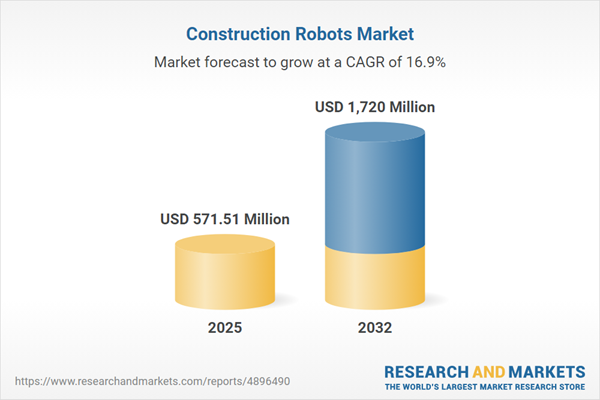Speak directly to the analyst to clarify any post sales queries you may have.
Construction robots are transforming the way projects are delivered by integrating automation, digital intelligence, and real-time analytics directly into job sites. As contractors and developers are pressed to improve efficiency and sustainability under tightening timelines and labor shortages, the construction robots market offers solutions poised to meet the demands of modern infrastructure growth and operational excellence.
Market Snapshot: Growth and Momentum in the Construction Robots Market
The construction robots market continues a robust upward trajectory, advancing from USD 494.77 million in 2024 to USD 571.51 million in 2025, and is expected to reach USD 1.72 billion by 2032 at a CAGR of 16.88%. Spurred by ongoing labor constraints, client requirements for higher quality outcomes, and evolving safety mandates, demand rises for robotics solutions that drive productivity, accuracy, and digital transparency across project life cycles.
Scope & Segmentation: Comprehensive Coverage of Key Segments and Technologies
This report provides an in-depth analysis of the full construction robotics landscape, assessing products, applications, and regional adoption. Segmentation includes:
- Type: Autonomous robots, collaborative robots (cobots), and remote-controlled robots
- Components: Hardware (actuators, controllers, sensors), services (consulting, maintenance), and software (design, operational platforms)
- End-use: Commercial, industrial, residential sectors
- Deployment: Off-site/prefabrication deployment, on-site deployment
- Application: Demolition and decommissioning, finishing, coating and sealing, inspection/monitoring/survey, material handling and onsite logistics, mechanical/electrical/plumbing tasks, site preparation and earthmoving, structural construction and erection
- Autonomy Level: Fully autonomous, semi-autonomous, teleoperated and remotely operated
- Region: Americas (including North America and Latin America), Europe/Middle East/Africa, and Asia-Pacific (with localized coverage across major economies)
- Company Profiles: Extensive examination of technology leaders and innovators shaping competitive differentiation and industry trends
Key Takeaways: Strategic Insights for Decision-Makers
- The construction robots market is shaped by evolving labor dynamics and demand for safer, more sustainable job sites.
- Integration of robotics with digital twin and IoT platforms increases real-time visibility, enabling smarter allocation of equipment and labor.
- Collaborative robots allow for human-machine partnerships, reducing fatigue and improving precision in tasks such as bricklaying and material handling.
- Robotic solutions that support both modular off-site assembly and autonomous onsite operations deliver flexibility and scalability throughout all project phases.
- Technology providers are advancing modular, interoperable platforms that adapt to regional requirements, supported by partnerships between hardware, software, and service leaders.
- Investing in workforce training and open architecture standards is foundational to reducing integration friction and supporting long-term automation strategies.
Tariff Impact: Navigating 2025 US Tariff Adjustments
Recent changes in United States tariff structures have increased complexities for supply chains, compelling manufacturers and integrators to reexamine sourcing and pricing. Emphasis is shifting to regional suppliers and contract manufacturers, while flexible procurement agreements and supply network resilience mitigate the impact of fluctuating duties. Companies engaging proactively with policymakers and developing robust contingency plans are better positioned to maintain competitiveness in the evolving regulatory landscape.
Methodology & Data Sources
This market study utilizes a rigorous methodology, combining primary research — including executive interviews and site visits — with comprehensive secondary analysis of industry publications, academic resources, and patent data. Data triangulation and consensus verification ensure accuracy, while regular peer reviews drive objective and consistent results.
Why This Report Matters: Actionable Outcomes for Industry Executives
- Identify the technology providers and partnerships delivering the greatest differentiation in construction robotics.
- Understand the regional trends, regulatory factors, and segment-specific adoption patterns critical for investment strategy.
- Access a clear roadmap for integrating robotics within operational and supply chain workflows, aligned with evolving sustainability and compliance demands.
Conclusion
Construction robotics is redefining productivity, safety, and precision across the sector. Leaders adopting advanced automation, resilient sourcing, and skills development will set the standard for sustainable project delivery and operational resilience in a dynamic market.
Additional Product Information:
- Purchase of this report includes 1 year online access with quarterly updates.
- This report can be updated on request. Please contact our Customer Experience team using the Ask a Question widget on our website.
Table of Contents
3. Executive Summary
4. Market Overview
7. Cumulative Impact of Artificial Intelligence 2025
Companies Mentioned
The companies profiled in this Construction Robots market report include:- ABB Ltd.
- Advanced Construction Robotics, Inc.
- Autonomous Solutions, Inc.
- Boston Dynamics Inc. by Hyundai Motor Group
- Brokk AB
- Built Robotics Inc.
- Caterpillar Inc.
- Conjet
- Construction Robotics, Inc.
- CyBe Construction B.V.
- DroneDeploy, Inc.
- FBR Limited
- Hilti Corporation
- Husqvarna Group
- ICON Technology, Inc.
- Komatsu Ltd.
- KUKA AG
- Liebherr Group
- MX3D B.V.
- Okibo Ltd.
- SZ DJI Technology Co., Ltd.
- Terex Corporation
- TopTec Spezialmaschinen GmbH
- Zoomlion Heavy Industry Science & Technology Co., Ltd.
Table Information
| Report Attribute | Details |
|---|---|
| No. of Pages | 198 |
| Published | November 2025 |
| Forecast Period | 2025 - 2032 |
| Estimated Market Value ( USD | $ 571.51 Million |
| Forecasted Market Value ( USD | $ 1720 Million |
| Compound Annual Growth Rate | 16.8% |
| Regions Covered | Global |
| No. of Companies Mentioned | 25 |









